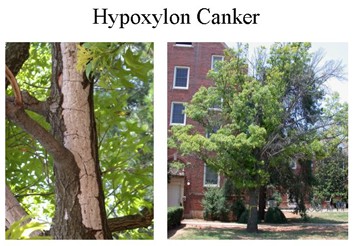 Description: The following is a description of hypoxylon canker in oak, taken from the Texas Plant Disease
Description: The following is a description of hypoxylon canker in oak, taken from the Texas Plant Disease
Handbook: “Hypoxylon Canker (fungus – Hypoxylon atropunctatum and other Hypoxylon spp.): The disease is first evident as a dieback of one or more branches. The foliage of the diseased limbs turns yellow and dries. This dieback continues from branch to branch through the stem until eventually the tree dies. This may require one or more years depending upon the environment and amount of stress experienced by the tree. Near death or shortly after tree death the outer bark sloughs off and exposes large masses of brown, dusty one-celled spores (conidia). These spores are gone within a few weeks and a grayish surface is visible. This is covered with numerous black fruiting structures.
Mature fruiting structures (perithecia) can forcibly discharge sexual spores (ascospores) for distances of 60 mm. They are then blown to surrounding trees where infection occurs again. Entry appears to be through injured surfaces on limbs or trunk. The fungus grows best at 86 degrees F but can grow at 50 and 100 degrees F.
Hypoxlon canker is not limited to oaks. Elm, pecan, hickory, sycamore, maple, beech and other trees may be infected. The fungus is known to be present in the inner bark of many healthy trees. When a tree is weakened or stressed, the fungus may then invade the sapwood and become one of several factors leading to death of the tree. Trees which have been damaged by excessive fill soil are often attacked by this organism.
Symptoms: Once the fungus invades the tree, the sapwood begins to decay rapidly. Trees killed by hypoxlon canker that are located near structures, roads, power lines, etc. need to be removed as soon as possible. Bucket trucks or lifts are the safest way to remove these trees, as the rapidly decaying wood many not support the weight of a climber.
Action: Control is achieved by maintaining the trees in a healthy condition. Avoid injury to the trunk and limbs and never apply fill-soil around the trees. Construction damage to roots also predisposes a tree to infection. Chemical treatments would not be effective because the fungus is located within the tree. During drought periods supplemental watering is recommended.
Thank you for reviewing this information. Schneider Tree Care is committed to preserving and enhancing the quality of your property through tree care education and services. We employ professionally trained and certified arborists who are available to meet with you for a consultation at no charge. If you have any questions or need additional information regarding the health of your trees, please contact us.





